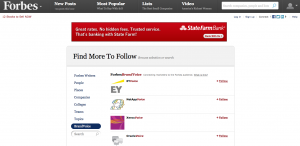Native Advertising: Q&A with Derek Singleton
We recently caught up Derek Singleton, Marketing Analyst at Software Advice, to hear his thoughts about native advertising and why marketers should start paying attention to this trend. Here is what he had to say:

Enveritas Group Q&A: Native Advertising
1. What is native advertising and why should marketers know about it?
Native advertising is a form of sponsored content that some are calling the “rebirth” of advertising. In case you are unfamiliar, native advertising refers to a new form of advertising that allows you to promote your content contextually without disrupting the user experience. This content can appear as part of an article, Infographic, webpage or social media feed without directly appearing as a traditional advertisement.
Marketers need to know about native advertising because the general public is increasingly becoming numb to predictable advertisements and tuning them out. Native advertising is a great way to circumvent this obstacle. Not to mention it actually works. In fact, IPG Media Lab and Sharethrough recently conducted a survey of nearly 5,000 consumers and found that people viewed native ads 53 percent more often than traditional ads.
2. How can native advertising help businesses? What are the benefits?
Native advertising can help businesses by getting their brand in front of their target audience. One great example of this is LinkedIn sponsored ads. LinkedIn gives advertisers the ability to filter their ads based on job titles, ages, industries, skills and other potentially useful target demographics. If a brand can create a great piece of engaging content and make sure the right people see it, this could go a long way to build their brand as a thought leader in their market. In some cases, it can also act as another lead generation channel. The IPG Media Lab and Sharethrough study I mentioned earlier, also found that consumers had an 18 percent higher purchase intent after viewing native ads when compared to a traditional banner ad.
3. What types of companies are utilizing this strategy?
Small businesses to Fortune 500 corporations are already utilizing this strategy. Technology companies appeared to be the early adopters of this trend, but now companies like General Electric, SAP, Porsche, The New York Times, and Target are all adding this strategy to their marketing portfolio.
4. How does native advertising fit within a general content marketing strategy?
Native advertising is a subset of content marketing, and it’s a paid advertisement that helps reach a wider audience with your content. Native ads allow you to repurpose existing content like, eBooks, whitepapers, data points and Infographics in an effort to reach a larger audience base.
5. What are the best channels to engage your consumers?
As always, what channel you choose to engage your customers really depends on where your customers can be found. For instance, consumer companies might have more luck on platforms like BuzzStream, while businesses might evaluate Forbes Brandvoice. The important thing is to know what websites your customers are visiting, and what kind of content piques their interest.
Social media is another great medium for native advertising. Twitter, LinkedIn, and Facebook all have some form of sponsored updates that can be delivered to a specific demographic. These types of filters go a long way in helping you deliver your content to a targeted audience.



